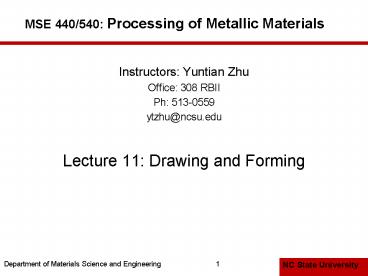MSE 440/540: Processing of Metallic Materials - PowerPoint PPT Presentation
1 / 20
Title:
MSE 440/540: Processing of Metallic Materials
Description:
MSE 440/540: Processing of Metallic Materials Instructors: Yuntian Zhu Office: 308 RBII Ph: 513-0559 ytzhu_at_ncsu.edu Lecture 11: Drawing and Forming – PowerPoint PPT presentation
Number of Views:238
Avg rating:3.0/5.0
Title: MSE 440/540: Processing of Metallic Materials
1
MSE 440/540 Processing of Metallic Materials
- Instructors Yuntian Zhu
- Office 308 RBII
- Ph 513-0559
- ytzhu_at_ncsu.edu
- Lecture 11 Drawing and Forming
2
Wire and Bar Drawing
- Similar to extrusion except work is pulled
through die in drawing - It is pushed through in extrusion
- Although drawing applies tensile stress,
compression also plays a significant role since
metal is squeezed as it passes through die
opening
3
Area Reduction in Drawing
- Change in size of work is usually given by area
reduction - The true drawing strain
4
Practical Drawing Force
sd is the exit stress
Average diameter (D0Df)/2
5
Drawing Practice and Products
- Drawing practice
- Usually performed as cold working
- Most frequently used for round cross sections
- Products
- Wire electrical wire wire stock for fences,
coat hangers, and shopping carts - Rod stock for nails, screws, rivets, and springs
- Bar stock metal bars for machining, forging, and
other processes
6
Bar Drawing
- Accomplished as a single-draft operation - the
stock is pulled through one die opening - Requires a batch type operation
http//www.youtube.com/watch?vejJ6Uqs5grU
http//www.youtube.com/watch?vQKAg1yMZIpY
7
Wire Drawing
- Continuous drawing machines consisting of
multiple draw dies (typically 4 to 12) separated
by accumulating drums - Each drum (capstan) provides proper force to draw
wire stock through upstream die - Each die provides a small reduction, so desired
total reduction is achieved by the series of dies
- Annealing sometimes required between dies to
relieve work hardening
8
Continuous Wire Drawing
http//www.youtube.com/watch?vYlLWBM2e5qgplaynex
t1listPL6DE0478CFB849C93featureresults_main
http//www.youtube.com/watch?v5-3ka0E-sl8
9
Features of a Draw Die
- Entry region - funnels lubricant into the die to
prevent scoring of work and die - Approach - cone-shaped region where drawing
occurs - Bearing surface - determines final stock size
- Back relief - exit zone - provided with a back
relief angle (half-angle) of about 30? - Die materials tool steels or cemented carbides
10
Sheet Drawing
- Sheet metal forming to make cup-shaped,
box-shaped, or other complex-curved,
hollow-shaped parts - Products beverage cans, ammunition shells,
automobile body panels - Also known as deep drawing (to distinguish it
from wire and bar drawing)
http//www.youtube.com/watch?v2ph3AOxvcR4feature
related
11
Deep Drawing of Cup
- Drawing of cup-shaped part (1) before punch
contacts work, (2) near end of stroke - Starting blank and drawn part shown in lower views
12
Clearance in Drawing
- Sides of punch and die separated by a clearance c
given by - c 1.1 t
- where t stock thickness
- In other words, clearance is about 10 greater
than stock thickness
13
Stages of the deformation
14
Drawing Ratio DR
- Most easily defined for cylindrical shape
(e.g., cup)
- where Db blank diameter and Dp punch
diameter - Indicates severity of a given drawing operation
- Upper limit DR ? 2.0
15
Reduction r
- Defined for cylindrical shape
- Value of r should be less than 0.50
16
Thickness-to-Diameter Ratio t/Db
- Thickness of starting blank divided by blank
diameter - Desirable for t/Db ratio to be greater than 1
- As t/Db decreases, tendency for wrinkling
increases
17
Blank Size Determination
- For final dimensions of drawn shape to be
correct, starting blank diameter Db must be right
- Solve for Db by setting starting sheet metal
blank volume final product volume - To facilitate calculation, assume negligible
thinning of part wall
18
Redrawing of a cup
19
Common defects
- Wrinkling in the flange (b) Wrinkling in
the wall - (c) Tearing (d)
Earing - (e) Scratches
20
HW assignment
- Reading assignment Chapters 14
- Review Questions 13.20, 13.21, 13.22, 14.9,
14.10, 14.12 - Problems 13.29, 13.31, 14.14, 14.15, 14.19,
14.22, 14.25






























